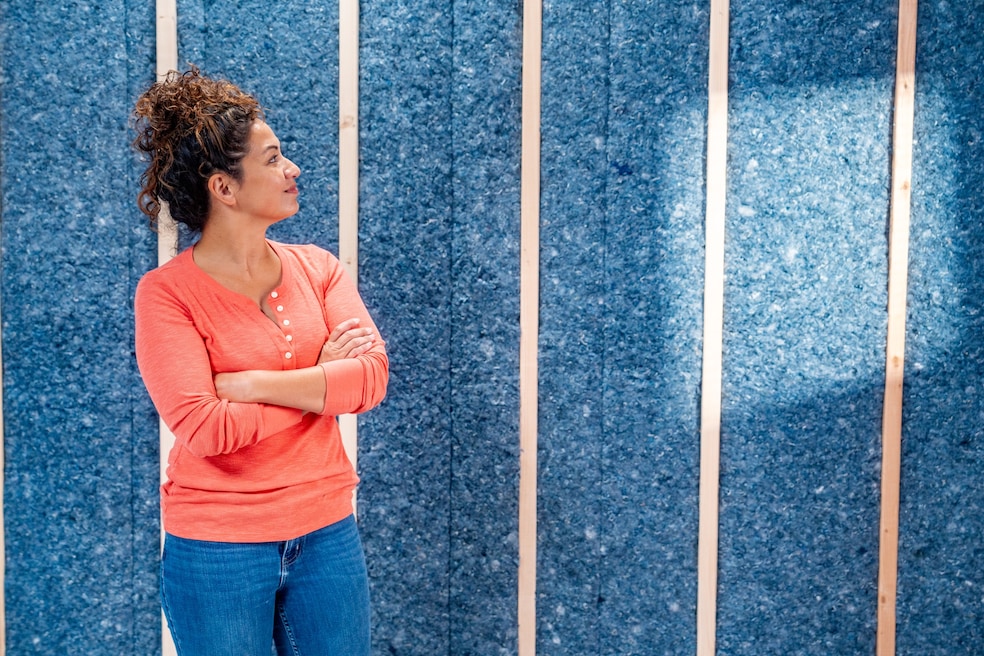When your jeans have seen their last day, maybe a casualty of changing trends, or maybe well-loved and worn threadbare — they can find a second life within the walls of your home.
Clothing retailer Madewell, for example, helps facilitate the process: You can bring your used jeans to a store and it will then shuttle them to a program that recycles the denim, turning the cotton material into a flexible block of indigo-hued insulation.
Despite growing in popularity over the past few years, the product isn’t new. The Arizona-based Bonded Logic launched in 2002, offering a post-consumer denim insulation branded as “UltraTouch.” In the realm of everyday building insulation options — fiberglass, cellulose, mineral wool — the recycled insulation came from a roughly five-step process:
| 1. Collect the jeans, find the denim that’s at least 90% cotton. |
| 2. Take off the metal buttons, zippers, and other decorative elements. |
| 3. Shred the fabric, unraveling even rigid denim into a fluffy blue puff. |
| 4. Treat the shredded denim with borate to make the cotton fire and mold-resistant. |
| 5. Compress that treated material into a chunky, perforated “batt” that a contractor or homeowner can easily use in a project. |
The option removes a whole slice of clothing from the waste stream — drawing interest from sustainable-minded building professions, especially in a moment where designers are increasingly focused on completing more efficient and eco-friendly structures. Earlier this year, Kimberton, Pennsylvania-based Carlisle Construction Materials acquired Bonded Logic, bringing the UltraTouch insulation under its Henry product range and spurring a fresh wave of online promotion geared toward the materials.
On Instagram, for instance, there’s a sizable trove of construction content creators that film themselves pressing chunks of dark blue insulation into the exposed studs of a project, introducing their followers to the material and its benefits.
One such creator, Sandy, Utah-based general contractor Stephanie Dailey, started using denim insulation earlier this year after seeing it at a trade show. Dailey, who joined the family-run Steven Dailey Construction in 2017, said her firm has only used the product a couple of times so far.
“The insulation market is primarily not a very sustainable market,” she explained. So there was a real “appeal behind finding a product that was not only a sustainable product but also something that was helping solve a landfill issue.”

Safer install makes it a good DIY fit, experts say
While some contractors are just dipping their toes into denim insulation, Natasha Winnik has been working with the material for nearly two decades.
Winnik launched the Tucson, Arizona, showroom Originate Natural Building Materials in 2003, and the denim insulation came on her radar around 2007; it was a relatively local option that was cheaper to source for her customers — insulation shipping prices can get lofty, she said.
“If you’re a DIY person it’s really great because you’re not itchy from touching fiberglass and you don’t have to cover all your skin and wear a mask,” she explained. “So, it’s great in terms of the ease of use and installation.”
It’s a sentiment Dailey echoed. “In addition to being environmentally friendly, they’re also easier to handle and safer to handle from an install perspective,” she said. With fiberglass insulation, she continued, contractors work carefully, cloaking themselves in personal protective equipment and masks.
“It can get into your lungs and cause a lot of issues,” she said. Plus, it's damaging to the skin. But denim insulation you can handle and cut with traditional tools.
Performs well in different climates and different acoustics
Dailey recently used denim insulation in a residential remodel that saw about 90% of its original building gutted. While it wouldn’t make great ceiling insulation, the denim is a natural replacement for a client using traditional batt insulation, she explained, especially “those projects that are looking for higher R-values," or a measurement of how efficiently an insulation performs.
Denim insulation can also offer “acoustic benefits as well as thermal benefits,” Winnik said. So, the house is quieter, she spelled out, and, depending on the climate and time of year, warmer or cooler. “It’s the kind of insulation that does both things.”
But for some users, the (increasing) cost can stack up
But performance and enhanced efficiency can come at a higher cost.
“If we’re comparing it to a standard fiberglass batt insulation, it is more expensive,” Dailey said. “But if we’re comparing it to a rock wool batt, they’re very similar in costs.”
The U.S.-made product is also insulated from some larger industry fluctuations that consumers might see, Winnik said, such as recent tariffs levied on building materials.
Since Carlisle bought Bonded Logic earlier this year, some long-time customers of its denim insulation — the perhaps most pervasive version in the country — have seen their prices rise by 40%.
The rise applies to “a small group of legacy customers who had pricing that was significantly below market and below the pricing offered to other partners for the same product,” explained a representative from the company over email. “For those specific accounts, we implemented a 40% adjustment to bring them in line with our standard rate. This alignment ensures fairness and consistency across our customer base and enables us to continue delivering high-quality products, reliable supply, and ongoing innovation in the UltraTouch line.”
Winnik, one of the customers impacted, found the increase “disappointing,” she said. “Until this acquisition, they were pretty much equal.”
